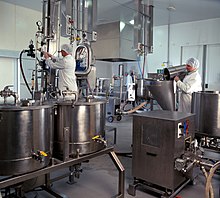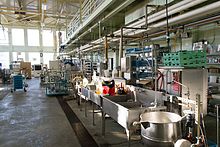Food science(orbromatology[1]) is thebasic scienceandapplied scienceoffood;its scope starts at overlap withagricultural scienceandnutritional scienceand leads through the scientific aspects offood safetyandfood processing,informing the development offood technology.


Food science brings together multiple scientific disciplines.[2]It incorporates concepts from fields such aschemistry,physics,physiology,microbiology,andbiochemistry.Food technologyincorporates concepts fromchemical engineering,for example.
Activities of food scientists include the development of new food products, design of processes to produce these foods, choice of packaging materials,shelf-lifestudies, sensory evaluation of products usingsurvey panelsor potential consumers, as well as microbiological and chemical testing.[3]Food scientists may study more fundamental phenomena that are directly linked to the production of food products and its properties.
Definition
editTheInstitute of Food Technologistsdefines food science as "the discipline in which the engineering,biological,and physical sciences are used to study thenature of foods,the causes ofdeterioration,the principles underlyingfood processing,and the improvement of foods for the consuming public ".[4]The textbookFood Sciencedefines food science in simpler terms as "the application of sciences and engineering to study the physical, chemical, and biochemical nature of foods and the principles of food processing".[5]
Disciplines
editSome of the subdisciplines of food science are described below.
Food chemistry
editFood chemistry is the study ofchemicalprocesses and interactions of all biological and non-biological components of foods.[6][7]The biological substances include such items asmeat,poultry,lettuce,beer,andmilk. It is similar tobiochemistryin its main components such ascarbohydrates,lipids,andprotein,but it also includes areas such as water,vitamins,minerals,enzymes,food additives,flavors,andcolors.This discipline also encompasses how products change under certainfood processingtechniques and ways either to enhance or to prevent them from happening.
Food physical chemistry
editFood physical chemistry is the study of both physical and chemical interactions in foods in terms of physical and chemical principles applied to food systems, as well as the application of physicochemical techniques and instrumentation for the study and analysis of foods.
Food engineering
editFood engineering is the industrial processes used tomanufacture food.It involves coming up with novel approaches for manufacturing, packaging, delivering, ensuring quality, ensuring safety, and devising techniques to transform raw ingredients into wholesome food options.[8]
Food microbiology
editFood microbiology is the study of themicroorganismsthat inhabit, create, orcontaminatefood,including the study of microorganisms causing food spoilage.[9]"Good" bacteria, however, such asprobiotics,are becoming increasingly important in food science.[10][11][12]In addition, microorganisms are essential for the production of foods such ascheese,yogurt,bread,beer,wineand, otherfermented foods.
Food technology
editFood technology is the technological aspect. Early scientific research into food technology concentrated on food preservation. Nicolas Appert's development in 1810 of the canning process was a decisive event. The process was not called canning then and Appert did not really know the principle on which his process worked, but canning has had a major impact on food preservation techniques.
Foodomics
editIn 2009, Foodomics was defined as "a discipline that studies the Food and Nutrition domains through the application and integration of advanced-omicstechnologies to improve consumer's well-being, health, and knowledge ".[13]Foodomics requires the combination of food chemistry, biological sciences, and data analysis.
Foodomics greatly helps scientists in the area of food science and nutrition to gain better access to data, which is used to analyze the effects of food on human health, etc. It is believed to be another step towards a better understanding of the development and application of technology and food. Moreover, the study of foodomics leads to other omics sub-disciplines, including nutrigenomics which is the integration of the study of nutrition, genes, and omics.
Molecular gastronomy
editMolecular gastronomy is a subdiscipline of food science that seeks to investigate the physical and chemical transformations of ingredients that occur in cooking. Its program includes three axes, as cooking was recognized to have three components, which are social, artistic, and technical.
Quality control
editQuality control involves the causes, prevention, and communication dealing withfood-borne illness.Quality control also ensures that the product meets specs to ensure the customer receives what they expect from the packaging to the physical properties of the product itself.
Sensory analysis
editSensory analysis is the study of how consumer's senses perceive food.
Careers in Food Science
editThe five most common college degrees leading to a career in food science are: Food science/technology (66%), biological sciences (12%), business/marketing (10%), nutrition (9%) and chemistry (8%).[14]
Careers available to food scientists include food technologists, research and development (R&D), quality control, flavor chemistry, laboratory director, food analytical chemist and technical sales.[15]
The five most common positions for food scientists are food scientist/technologist (19%), product developer (12%), quality assurance/control director (8%), other R&D/scientific/technical (7%), and director of research (5%).[14]
By country
editAustralia
editThe Commonwealth Scientific and Industrial Research Organisation (CSIRO) is the federal government agency for scientific research inAustralia.CSIRO maintains more than 50 sites across Australia and biological control research stations in France and Mexico. It has nearly 6,500 employees.
South Korea
editThe Korean Society of Food Science and Technology, or KoSFoST, claims to be the first society in South Korea for food science.[16][non-primary source needed]
United States
editIn the United States, food science is typically studied atland-grant universities.Some of the country's pioneering food scientists were women who attended chemistry programs at land-grant universities which were state-run and largely under state mandates to allow for sex-blind admission. Although after graduation, they had difficulty finding jobs due to widespread sexism in the chemistry industry in the late 19th and early 20th centuries. Finding conventional career paths blocked, they found alternative employment as instructors in thehome economicsdepartments and used that as a base to launch the foundation of many modern food science programs.[citation needed]
The main US organization regarding food science andfood technologyis theInstitute of Food Technologists(IFT), headquartered inChicago, Illinois,which is the US member organisation of theInternational Union of Food Science and Technology(IUFoST).[citation needed]
See also
editPublications
editBooks
editFood Science is an academic topic so most food science books are textbooks.
Journals
edit- Applied Food Biotechnology
- Chemical Senses
- Food and Bioprocess Technology
- Food Chemistry
- Food Research International
- Food Quality and Preference
- Journal of Dairy Science
- Journal of Food Science
- Journal of Sensory Studies
- Journal of Texture Studies
- LWT – Food Science and Technology
- Trends in Food Science & Technology
Notes and references
edit- ^Habib, Muhammad Tahir."What is Bromatology: Definition & Facts".Pakistan Food and Nutrition Organization.Retrieved2024-10-03.
- ^Ward, Janet D.; Ward, Larry T. (21 May 2013).Principles of Food Science.Goodheart-Willcox Company, Incorporated.ISBN978-1619604360.
- ^"Food Science Activity Guides".IFT.org.Archived fromthe originalon March 27, 2015.RetrievedFebruary 2,2015.
- ^Heldman, Dennis R. "IFT and the Food Science Profession."Food Technology.October 2006. p. 11.
- ^Potter, Norman N.; Hotchkiss, Joseph H. (1998).Food Science.Food science texts series (5th ed.). Springer.ISBN9780834212657.
- ^John M. de Man.1999.Principles of Food Chemistry(Food Science Text Series), Springer Science, Third Edition
- ^John M. de Man. 2009. Food process engineering and technology, Academic Press, Elsevier: London and New York, 1st edn.
- ^Expert, E. R. P. (2023-03-21)."Food Engineering (Goals, Processes, Practices, and Technologies)".erp-information.Retrieved2023-10-09.
- ^Fratamico PM (2005). Bayles DO (ed.).Foodborne Pathogens: Microbiology and Molecular Biology.Caister Academic Press.ISBN978-1-904455-00-4.
- ^Tannock GW, ed. (2005).Probiotics and Prebiotics: Scientific Aspects.Caister Academic Press.ISBN978-1-904455-01-1.
- ^Ljungh A, Wadstrom T, eds. (2009).Lactobacillus Molecular Biology: From Genomics to Probiotics.Caister Academic Press.ISBN978-1-904455-41-7.
- ^Mayo, B (2010). van Sinderen, D (ed.).Bifidobacteria: Genomics and Molecular Aspects.Caister Academic Press.ISBN978-1-904455-68-4.
- ^Cifuentes, Alejandro (23 October 2009)."Food analysis and Foodomics".J. Chromatogr. A.1216(43): 7109.doi:10.1016/j.chroma.2009.09.018.hdl:10261/154212.PMID19765718.
- ^ab"2019 IFT Employment and Salary Survey Facts and Figures - IFT.org".
- ^"What kind of careers do Food Scientists have?".Washington State University. Archived fromthe originalon 20 March 2022.Retrieved1 September2021.
- ^"Korean Society of Food Science and Technology (KoSFoST)".KoSFoST. Archived fromthe originalon 22 October 2021.Retrieved11 December2016.
Further reading
edit- Wanucha, Genevieve (February 24, 2009)."Two Happy Clams: The friendship that forged food science".MIT Technology Review.
External links
edit- Media related toFood scienceat Wikimedia Commons
- Learn aboutFood Science